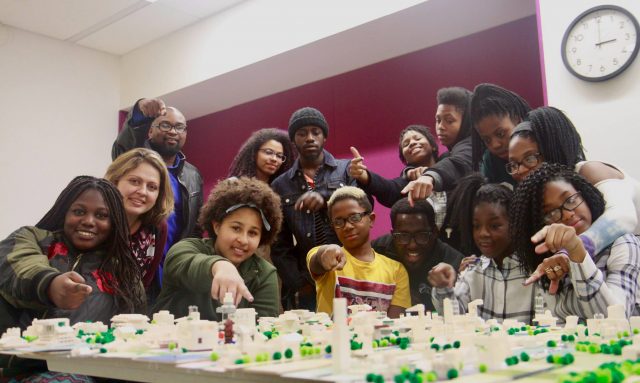 In front of 10-year-old Sanaii Makayla Brazil Broach sits a vinyl record with carefully placed white Lego, each representing something she thinks is important to a community. In the center is a the largest Lego building: a community center for families. Smaller buildings, police stations and hospitals, encircle it. Her city also has many small green balls dispersed everywhere on the record, symbolizing trees and wildlife. Finally, there is another Lego building: a Nike outlet.
In front of 10-year-old Sanaii Makayla Brazil Broach sits a vinyl record with carefully placed white Lego, each representing something she thinks is important to a community. In the center is a the largest Lego building: a community center for families. Smaller buildings, police stations and hospitals, encircle it. Her city also has many small green balls dispersed everywhere on the record, symbolizing trees and wildlife. Finally, there is another Lego building: a Nike outlet.
 Broach is one of several young people who have learned about the intersections of hip-hop within architecture and created innovative models of communities through Hip Hop Architecture Camp’s third session last Saturday. After attending Hip hop Architecture, spearheaded by architect Michael Ford and others, Broach is inspired and considering pursuing architecture in the future, second to wanting to be a businesswoman or dancer.
Broach is one of several young people who have learned about the intersections of hip-hop within architecture and created innovative models of communities through Hip Hop Architecture Camp’s third session last Saturday. After attending Hip hop Architecture, spearheaded by architect Michael Ford and others, Broach is inspired and considering pursuing architecture in the future, second to wanting to be a businesswoman or dancer.
Broach said she enjoyed being able to come to gain a new experience. She said in an interview with Madison365 that she believes Madison communities need more accessible grocery stores and community centers for families to spend time together.
Ford believes that this camp will help express the needs of communities through the truthful and unfiltered voices of the youth who grow up in these underprivileged environments.

Broach “kept saying grocery store,” Ford said. “If you ask a lot of folks in Madison, they’ll say there’s a lot of fresh food everywhere but there are still kids who feel like that their families don’t have access to fresh food.”
Houston Wamble, an eighth grader at Badger Rock Middle School, believes that the Hip Hop Architecture camp is beneficial particularly for younger kids as a healthy and creative fun outlet on Saturdays as an alternative to “getting in trouble.”
“I’m noticing how much Madison needs help,” Wamble said.
Wamble described his ideal community to be “safer.” He added that he wanted to see “unnecessary violence” eradicated from his community and that there should be more shelters for the homeless and less expensive homes. “More kids need to be active in our community instead of looking out for trouble,” Wamble said.

Fifth grader Alex Ralym wants to be a doctor or social activist when she grows older, adding architecture to one of her possible careers. At the camp, Ralym learned the technicalities of architecture such as how buildings work, the best way to place them in a community, and how to position them so all people can have access. She enjoyed the friendliness of the environment, learning about how hip hop has helped report on problems in communities, and thinks it is important to have programs like these where kids can truly express themselves and their personalities through their creativity.
Ford hopes that this program has provided a space for kids to recreate their imaginations and hopes that kids will see pursuing architecture as a tangible career, even though only two percent of architects are African Americans. He also hopes that the kids will use their creative minds to innovate a style of architecture that can be specifically “black style.”
“So letting them know they have the opportunity to create that and let them know that hip-hop, which they do all day every day — that’s our life, it’s the perfect thing to bring into architecture. They can bring something no one’s ever seen before,” Ford said.

In continuing to provide spaces to facilitate youth of Madison’s creativity and inspire them to go beyond their expectations, the Hip Hop Architecture camp hopes to reach more of Madison’s youth and see their needs implemented into neighborhoods in Dane County by the city of Madison.
“There are few spaces where professionals or academics can be open like this to let kids express themselves in their own unique way. Too many times we want to try to raise kids instead of letting them be themselves and meet them where they are,” Ford said.
The Hip Hop Architecture Camp has one more session tomorrow, 11 am until 3 pm at Madison Central Library. It is free and open to middle and high school students.
This piece was produced by a student reporter in the Madison365 Academy. To learn more and support our education programs, visit madison365.org/academy.




























